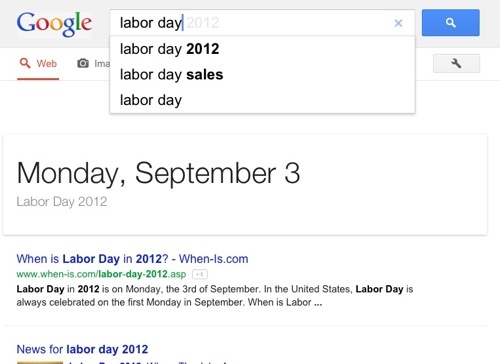Labor Day is about taking a day off work and buying reduced-price consumer goods, if Google’s suggested search terms are any indication.

The actual history of Labor Day is a bit more interesting than that. It is also a bit more “socialist,” considering that much of the impetus for declaring a national holiday revolved around labor unions in the 1880’s and 1890’s. The U.S. Department of Labor has a historical summary of how the first Labor Day celebration took place in 1882, and how it grew from there:
Labor Day: How it Came About; What it Means
Labor Day, the first Monday in September, is a creation of the labor movement and is dedicated to the social and economic achievements of American workers. It constitutes a yearly national tribute to the contributions workers have made to the strength, prosperity, and well-being of our country.
***
The First Labor Day
The first Labor Day holiday was celebrated on Tuesday, September 5, 1882, in New York City, in accordance with the plans of the Central Labor Union. The Central Labor Union held its second Labor Day holiday just a year later, on September 5, 1883.
In 1884 the first Monday in September was selected as the holiday, as originally proposed, and the Central Labor Union urged similar organizations in other cities to follow the example of New York and celebrate a “workingmen’s holiday” on that date. The idea spread with the growth of labor organizations, and in 1885 Labor Day was celebrated in many industrial centers of the country.Labor Day Legislation
Through the years the nation gave increasing emphasis to Labor Day. The first governmental recognition came through municipal ordinances passed during 1885 and 1886. From them developed the movement to secure state legislation. The first state bill was introduced into the New York legislature, but the first to become law was passed by Oregon on February 21, 1887. During the year four more states — Colorado, Massachusetts, New Jersey, and New York — created the Labor Day holiday by legislative enactment. By the end of the decade Connecticut, Nebraska, and Pennsylvania had followed suit. By 1894, 23 other states had adopted the holiday in honor of workers, and on June 28 of that year, Congress passed an act making the first Monday in September of each year a legal holiday in the District of Columbia and the territories.
A story on “The Origins of Labor Day” from PBS, first published in 2001, presents a far-less rosy view of how the holiday came to be:
Conceived by America’s labor unions as a testament to their cause, the legislation sanctioning the holiday was shepherded through Congress amid labor unrest and signed by President Grover Cleveland as a reluctant election-year compromise.
The 1880’s and 90’s featured considerable labor unrest, and a number of prominent strikes figured into the decision to make Labor Day a federal holiday. A big one was the Pullman Strike of 1894, in which almost 4,000 non-unionized Pullman employees (the company that made railroad sleeper cars) walked off the job to protest pay cuts. They lived in Pullman, Illinois, a planned company town where the company owned almost everything, rent was deducted directly from employees’ wages, and Mr. Pullman ruled everything like a feudal baron.
The company fired hundreds of workers during an economic depression in 1893, then cut everyone else’s wages. It did not, however, lower rent, so people’s real income plummeted. A boycott of Pullman railroad cars resulted in 125,000 rail workers refusing to handle the company’s cars. The strike ended after President Grover Cleveland (in his second non-consecutive term in office) deployed 12,000 Army troops and thousands of U.S. Marshals to Pullman. Thirteen strikers were killed, at least two in direct confrontation with federal troops. This and other strikes created political pressure that led to Labor Day as a statutory federal holiday:
The movement for a national Labor Day had been growing for some time. In September 1892, union workers in New York City took an unpaid day off and marched around Union Square in support of the holiday. But now, protests against President Cleveland’s harsh methods made the appeasement of the nation’s workers a top political priority. In the immediate wake of the strike, legislation was rushed unanimously through both houses of Congress, and the bill arrived on President Cleveland’s desk just six days after his troops had broken the Pullman strike.
1894 was an election year. President Cleveland seized the chance at conciliation, and Labor Day was born. He was not reelected.
In a sense, the Labor Day holiday is a concession to the labor unions of the 19th century. As an interesting postscript of sorts to this story, Grover Cleveland didn’t even get his own party’s nomination in 1896. The Democrats chose William Jennings Bryan instead, who lost in the general election to the business-friendly Republican William McKinley. McKinley was assassinated in 1901, elevating his Vice President, Theodore Roosevelt, to the White House. Students of history know that Teddy Roosevelt did quite a bit to curb many of the excesses of government and industry and help workers.

